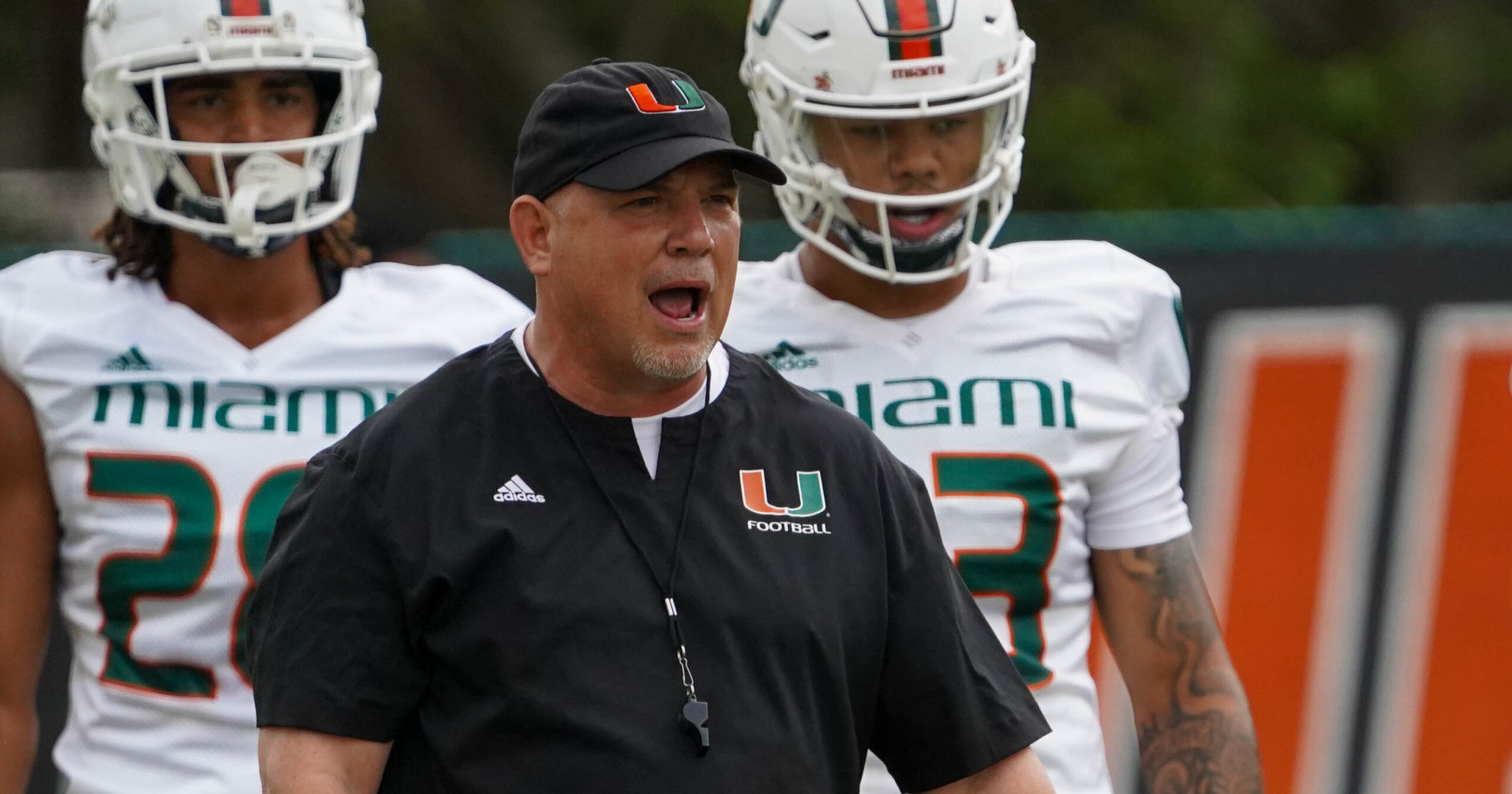ANALYSIS: Realistic expectations Miami Hurricanes 2023 defense

Realistic expectations for this year’s Miami Hurricanes offense
There are different ways to quantify expectations for a particular side of the ball. Personnel losses/key returners is one way to do it, with the performance metrics side included from the prior year (yards allowed, points given up per game, etc.). To some extent, that’s a worthwhile endeavor for this year’s Miami defense.
But then you also have to factor in the impact of a new coordinator, with Lance Guidry taking over for a Kevin Steele D that was heavy on rotations and was not as aggressive as the approach Guidry favors.
For starters, though, let’s look at the major losses from 2022. Up front the team will miss starting DT Darrell Jackson (3 sacks) as well as part-time starting DE Mitchell Agude (7 TFL, 4 sacks, 6 starts) and part-time starting LB Caleb Johnson (48 tackles, 4 TFL, 4 starts). Plus both starting corners are gone, Tyrique Stevenson (2 INT, 7 PBU) and DJ Ivey (2 INT, 5 PBU).
The top returners: Starting DE Akheem Mesidor (10.5 TFL, 7 sacks), DE Jahfari Harvey (5.5 sacks), starting DT Leonard Taylor (10.5 TFL, 3 sacks) plus backup DE Nyjalik Kelly (4 sacks) along with starting LB Corey Flagg (10.5 TFL, 2.5 sacks), LB Wesley Bissainthe (30 tackles, 3 starts) and LB Keontra Smith (33 tackles, 3 TFL, 3 starts). In the back end starting nickel Te’Cory Couch (37 tackles, 6 PBU) returns along with All-American safety Kam Kinchens (59 tackles, 6 INT) and rising star safety James Williams (58 tackles, INT, 6 PBU).
Then sprinkle in a true freshman like DE Reuben Bain, who had 3 sacks in the Spring Game, along with a host of transfers. That latter group includes DTs Branson Deen (first-teamer this spring) and Thomas Gore, LB Francisco Mauigoa (appears to have leg up to start over Flagg) and CBs Davonte Brown and Terry Roberts (Brown was a consistent first teamer in the spring).
As you can see from the above, there is a good amount of talent returning, and guys in the portal that can help provide depth and upgrade talent at their respective positions.
So that’s all a positive.
Now let’s turn to what this Miami defense accomplished last season. In part because the offense faltered so badly, the attention wasn’t so much on a defense that could also be pointed to as underachieving. The Canes ranked No. 64 in the nation in total defense (376.5 yards allowed per game), No. 54 in rush defense (142.9 yards), No. 79 in passing yards allowed (233.6 yards), No. 66 in scoring defense (26.8 points), No. 97 in third down conversion percentage defense (40.4 percent converted), No. 61 in red zone defense (0.830) and No. 101 out of 130 teams in team passing efficiency defense (142.52).
So it was a defense that rated around the middle of the pack in some areas and toward the bottom in others.
There is a lot of room for improvement.
Enter Guidry.
His Marshall D a year ago? That group ranked in the top 30 of the nation in 10 different major defensive categories including No. 1 in third down conversion pct defense (.235), No. 3 in pass efficiency defense (104.67), No. 4 in rush defense (93.0 yards), No. 6 in scoring defense (16.0 points), No. 7 in total defense (294.5 yards), No. 8 in first downs defense (200), No. 15 in sacks (2.92 per game) and No. 19 in red zone defense (.767).
A key individual game result from his unit? Marshall defeated Notre Dame, 26-21 – in that game the Irish had 130 rush yards (3.5 YPC) and 221 pass yards but only found the end zone three times. The Marshall D confused QBs Tyler Buchner and Drew Pyne to the point they threw three interceptions, and the defense had two sacks and two QB hurries. The Irish offense converted just four of 13 third downs.
Notre Dame, by the way, checked in at No. 41 in the nation in scoring offense (31.8 points) at the end of last year, so it was a decent attack.
You look at the rest of Marshall’s games, and in each of them other than Bowling Green the opponent had less than its season average in points.
Norfolk State (3 points): No. 109, averaged 17.2 points
Bowling Green (34 points in OT): No. 97, 23.5 points
Troy (16 points): No. 80, 25.6 points
Gardner-Webb (7 points): No. 28, 32.2 points
Louisiana (23 points): No. 77, 26.2 points
James Madison (12 points): No. 13, 37.0 points
Coastal Carolina (24 points): No. 59, 29.1 points
Old Dominion (shutout): No. 115, 19.5 points
App State (21 points): No. 22, 34.9 points
Georgia Southern (10 points): No. 33, 32.7 points
Georgia State (23 points): No. 53, 30.0 points
UConn (14 points): No. 116, 19.4 points
Guidry makes a habit of confusing offenses by using a variety of looks with the same personnel. He runs a 4-2-5, typically with two tackles with their hands in the dirt and stand up ends. Having seven in the box is the norm for his defenses, and he isn’t shy about leaving his boundary corners on an island. It’s an exciting style that dares the offense to make a play.
It worked well the last couple of years at Marshall, and yes we know the Sun Belt isn’t the ACC. But Guidry’s D outperformed the average of other teams’ scoring offenses in 12 of the 13 games. That’s pretty good, and that’s not a coincidence. Guidry’s system confuses opponents.
Given Miami’s returning pieces, Guidry’s success at Marshall and the style of defense he runs, it’s a fair bet there will be a spike up in the national rankings for the Hurricanes’ D this season.
It was a low bar set last year for a Miami defense that was once upon a time always among the nation’s best, a unit feared by opposing offenses.
Now Guidry and this group is looking to get back to that.
The post ANALYSIS: Realistic expectations Miami Hurricanes 2023 defense appeared first on On3.
